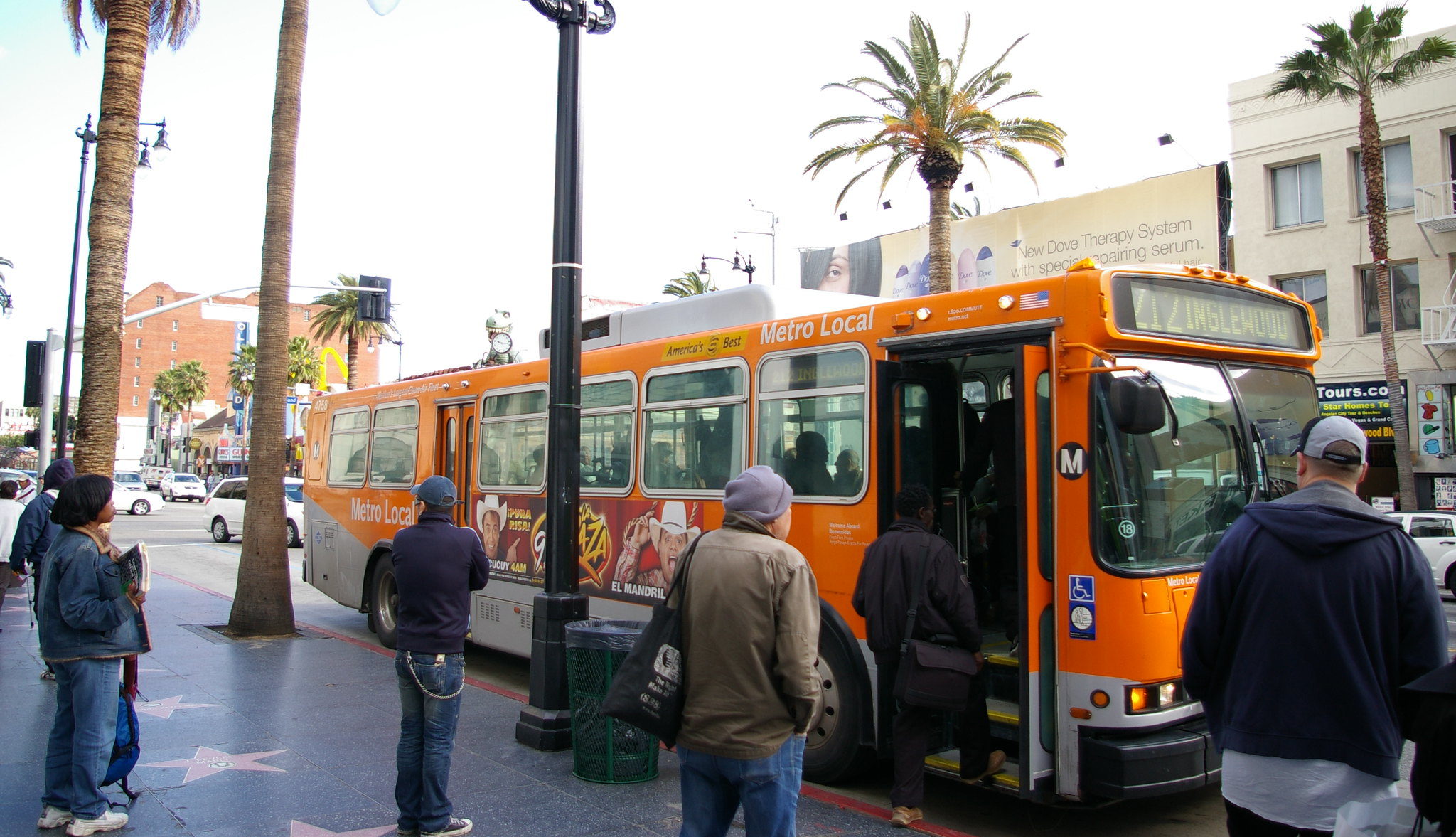
Earlier this year, we published a post about fluctuating transit service levels throughout 2021 at the seven highest ridership agencies – New York’s MTA, CTA, LA Metro, SFMTA, SEPTA, MBTA, and WMATA.
This week, we’re running a series which looks at service levels across modes at each of these seven agencies for the first quarter of 2022, and provides contextual discussion about what riders can expect through the rest of the year, based on interviews with agency staff and local transit advocates. Our goal with this series is to facilitate a shared understanding of the challenges agencies are facing amidst a national bus operator shortfall, public safety concerns, and the effects of deferred maintenance. We’re also aiming to give riders a sense of what they can expect for the remainder of 2022, and surface ideas for how agencies can better mitigate the disruptions that many riders are experiencing.
All chart data is from the Federal Transit Administration’s National Transit Database (Monthly Module Adjusted Data Release, April 2022. Service data is available through May 2022 but continues to be updated past its initial release–we include data only through April to ensure accuracy.)
We’re kicking off this series off with LA Metro, profiled below, but first, a look at transit service level trends in the aggregate:
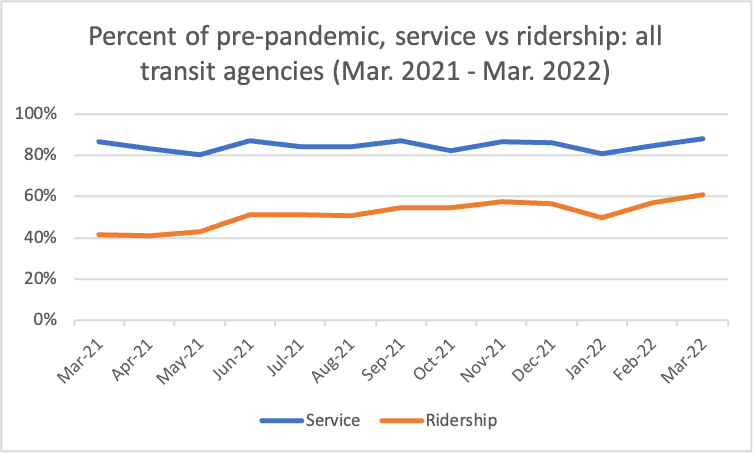
Nationwide, service levels (service hours) through the first three months of 2022 averaged 84% of pre-pandemic service with a clear progression from January (81%) to March (88%.) Ridership (unlinked passenger trips) followed a similar trend, increasing from 50% of pre-pandemic trips in January to 61% in March. Early 2022’s service and ridership trends track with the same period in 2021: gradual increases following COVID surges during the 2020 and 2021 holiday seasons.
Service levels and ridership continue to vary significantly by metro area and by agency. In the 21 metro areas with the highest transit ridership, service levels ranged from 80% (Baltimore) to 99% (New York City) of pre-pandemic service in March. Ridership ranged from 46% (Atlanta) to 75% (Miami) of pre-pandemic figures.
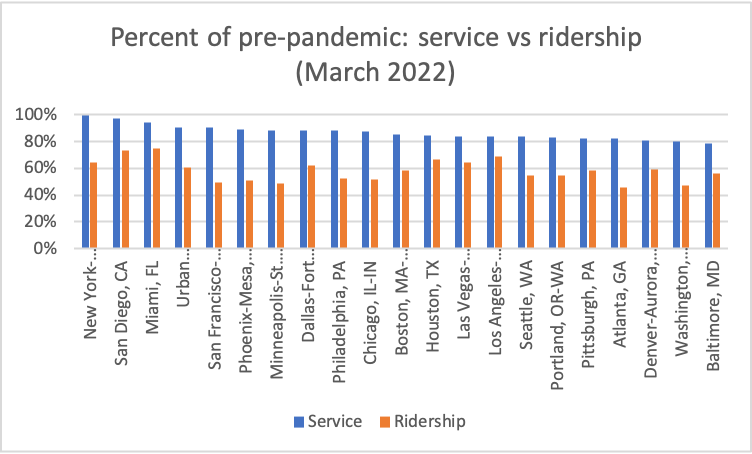
For the nation’s seven largest transit agencies, service levels and ridership grew beyond March’s figures (latest available NTD data at time of writing.) Yet operator and general workforce shortages have continued to undercut agencies’ commitments to deliver 100% or more of pre-pandemic service. (See: TransitCenter’s related publication Bus Operators in Crisis.)
We anticipate that the following three themes will have the biggest impact on service delivery at these agencies going forward:
- Ongoing workforce shortages and staffing challenges. Agencies are in the midst of reforming recruiting, hiring, and workplace policies to better attract workers, but have yet to fully realize those reform’s benefits and still struggle to outpace attrition.
- Adaptation to new travel patterns. Five of the seven largest transit agencies are undertaking or have just completed bus network redesigns.
- Service impacts related to acute, safety-related incidents or crises, as in Washington, D.C. and Boston. While limited to only a few agencies, this will be an area to monitor going forward. We are still learning more about the structural causes behind these incidents, but it seems likely that they are related, at least in part, to the same staffing challenges affecting the industry as a whole. In March, staff at SFMTA, which has faced its own difficulties hiring and retaining skilled maintenance workers, expressed concern to TransitCenter about the transit industry’s medium- and long-term capacity to keep systems in states of good repair.
What’s going on with service at LA Metro?
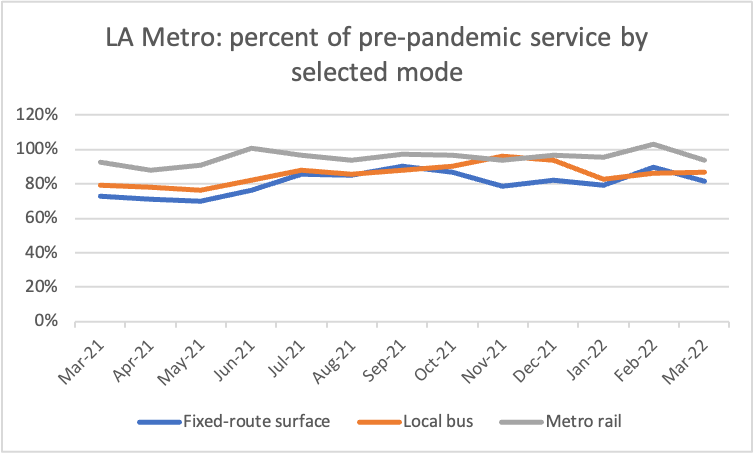
LA Metro struggled to deliver planned service in early 2022 amidst the Omicron COVID wave, which all but collapsed the agency’s effort to implement its NextGen Bus Plan. Eli Lipmen, executive director of local advocacy group Move LA, noted the real hardship that lengthened headways and “ghost trips” (as opposed to canceled trips that are communicated as such) have posed to riders.
Metro has made progress in slowing its workforce shrinkage, adding a net 19 bus operators between February and May 2022, and in May passed its largest-ever budget in order to restore service and actualize the NextGen plan. Metro’s Joe Forgiarini (Senior Director, Service Performance and Analysis) shared the following 2022 priorities with TransitCenter:
“Achieving 100% of pre-pandemic service levels based on our NextGen Bus Plan is a high priority for our Board. Metro dropped 10% of directly operated service in February 2022 to reduce canceled service and improve reliability. Metro is restoring about 30% of the February 2022 reduction from June 26th, though we had to reduce contracted services (these are about 7% of our total bus revenue hours.) We hope to restore full service by [the] end of 2022 or sooner, subject to enough new bus operator hires.”
Forgiarini also emphasized the continued roll-outs of bus speed improvements – new bus lanes and signal priority – as one of the agency’s main objectives in 2022.
In addition to operator recruitment and retention challenges, both Lipmen and Forgiarini identified the need to address public safety concerns, code of conduct violations, and an increasing number of riders experiencing homelessness sheltering on the system.
Forgiarini says that LA Metro is “boosting funding for public safety by 12.5 percent over the current year and putting that money into our Reimagining Public Safety initiative. The effort will: expand our transit ambassador program; grow our homeless and mental health outreach activities; continue our work with law enforcement agencies that help patrol our system, and; add unarmed security officers to the system.”
Coming tomorrow: Boston’s MBTA and Chicago’s CTA
 LA is (Not-So) Quietly Adding a LOT of Bus Lanes
LA is (Not-So) Quietly Adding a LOT of Bus Lanes
Thanks to the persistent work of local transit advocates, LA Metro is laying down 30 miles of bus lanes in 2023, pushing the total number of bus lanes in LA County to 40 miles.
Read More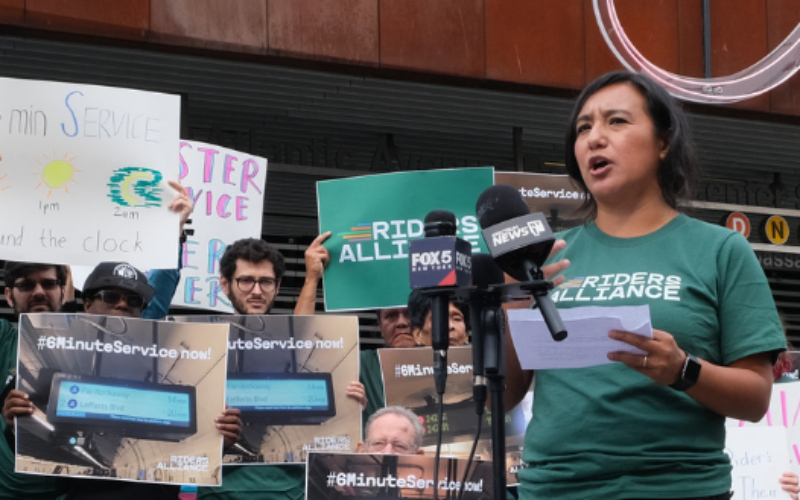 Built to Win: Riders Alliance Campaign Secures Funding for More Frequent Subway Service
Built to Win: Riders Alliance Campaign Secures Funding for More Frequent Subway Service
Thanks to Riders' Alliance successful #6MinuteService campaign, New York City subway riders will enjoy more frequent service on nights and weekends, starting this summer. In this post, we chronicle the group's winning strategies and tactics.
Read More